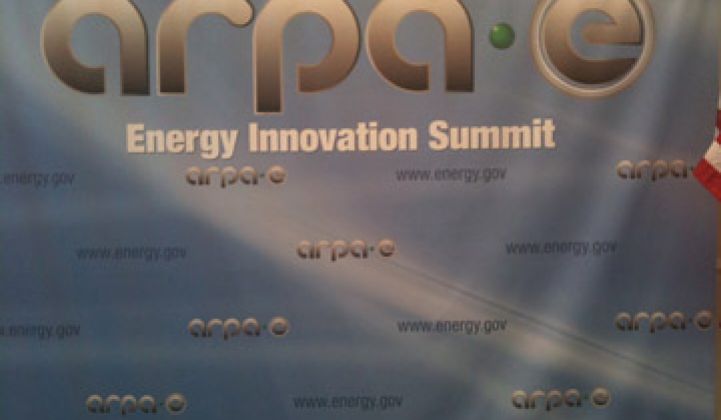At the Advanced Research Projects Agency-Energy Innovation Summit on Wednesday, Representative Steve Israel (D-NY) joked that he would be brief in his remarks because “the lights are going to go off in about 10 minutes.” Although the conference, which drew more than 2,000 attendees, wasn’t held in a government building, that doesn’t mean that the research arm of the U.S. Department of Energy isn’t threatened by the budget cuts being debated in Congress.
But unlike so many other areas of federal investment, ARPA-E has friends in the right places: the Department of Defense. Just after Rep. Israel spoke of the need for innovation in fuels and storage, U.S. Secretary of the Navy Ray Mabus announced a partnership between his department and the DOE in two areas of energy storage. Less than two years after Secretary Steven Chu announced $400 million in funding opportunities for ARPA-E, the agency is leveraging its role in national security to keep the money flowing during tough times.
“ARPA-E is a kindred spirit with the department of the Navy,” said Mabus.
The first project will develop hybrid energy storage that can rapidly charge and discharge and can be used in a variety of settings, from bases to outposts to ships. Both departments will receive $25 million for the project.
The second project will build on ARPA-E’s Grid-Scale Rampable Intermittent Dispatchable Storage, or GRIDS, research that is developing large-scale grid storage. Funding for the project was not yet finalized. “If you’re talking about national security, you’re talking about oil first and the second is our grid,” said Arun Majumdar, Director of ARPA-E. “ If we can help the DOD, it’s a win for our nation.”
Not only is the DOD a research partner, but it is also a market for technologies that can then be adopted on a larger scale. It is still early days for ARPA-E and many technologies may take decades to commercialize, but the DOD’s needs for reliable energy will help foster much-needed energy storage advancement that the grid needs now.
Although Majumdar talked about the time it will take to scale, he also pointed to early success stories. General Compression received $750,000 from ARPA-E to develop their compressed air energy storage technology at a lower cost. After that award, the Newton, Mass.-based company has received an additional $12 million from investors.
But there’s a whole lot more than energy storage going on, and Majumdar is excited about all of it. “The fuel side excites me a lot,” he said, noting the electrofuels program that is working on technologies that don’t use petroleum or biomass. He pointed to companies like OPX Biotechnologies, which was awarded $6 million. The company is taking energy from hydrogen gas to convert carbon dioxide into liquid transportation fuel at less than $2.50 per gallon. He’s also hedging his bets. “For the domestic transportation -- there is a chance none of [these fuels] will win,” he said.
Enter the electrification of transportation, where ARPA-E is also working on cheaper, better batteries. “That is absolutely critical,” he said. And how are all of these cars going to get around? Well, ARPA-E is trying to take down the price of solar while also developing the quantum leaps in grid efficiencies to be able to deliver the renewable energy.” You might as well go ahead of the Chinese and put in those next technologies,” said Majumdar.
If jumping ahead of the Chinese sounds bold, it’s because it is. ARPA-E is not delusional about the fact that the research and development will take time, but Majumdar is confident that in five years, and maybe less, there will be indicators of what those game changers will be. He expects that five years from now, we’ll see even more private money flowing to promising developments and patents being licensed.
As for the gathering this week in Washington, which featured nearly 500 technologies in a showcase, Majumdar smiled like a kid in a candy store at the possibilities that lie ahead, despite an uncertain political environment. “This is the Woodstock of energy innovation,” he said. "I’m having a blast.”
Watch Majumdar's full keynote address for more on the intersection of energy, national and environmental security:



